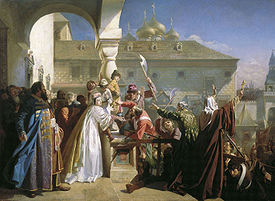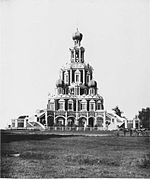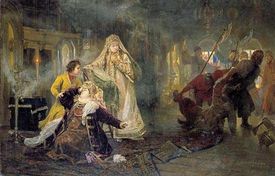- Moscow Uprising of 1682
-
Moscow Uprising of 1682, also known as Streltsy Uprising of 1682 (Russian: Стрелецкий бунт), was an uprising of the Moscow Streltsy regiments which resulted in supreme power being devolved on Sophia Alekseyevna. Behind the uprising was the rivalry between the relatives of the two wives of the late Tsar Alexis I of Russia for the dominant influence on the politics of Muscovy.
The uprising was triggered by the death of Feodor III of Russia on 27 April. The Naryshkin brothers of Tsarina Natalia Naryshkina availed themselves of the interregnum and persuaded the Patriarch to proclaim her ten-year-old son Peter as a new Tsar of Russia. In their turn, the Miloslavsky party, which comprised the relatives of the late Tsarina Maria Miloslavskaya, spread rumours that her son, Peter's elder half-brother Ivan, had been strangled by the Naryshkins in the Moscow Kremlin.
The Miloslavsky conspirators stirred up riots in the streets of the capital. They used the discontent of the Moscow regiments against their commanding officers and on 11 May 1682 the mob of the Streltsy took over the Kremlin and lynched the leading boyars and military commanders whom they suspected of corruption — Artamon Matveev, Mikhail Dolgorukov, and Grigory Romodanovsky.
A few days later, on 17 May, the rebels once again stormed the royal residence and killed a number of Naryshkin supporters, including two of the Naryshkin brothers (Kirill and Ivan) in the presence of the young tsar Peter, their nephew. The Streltsy were joined by mobs of poor people and looted the streets of Moscow for several days. The May uprising led to Peter's older half-brother Ivan V being proclaimed as the "first" tsar, while young Peter I was relegated to the second position, with Sophia acting as a regent for them both.
In the fall of 1682 Prince Ivan Andreyevich Khovansky (Taratui) — Sophia's close associate and one of the leaders of the rebellious Streltsy — turned against her. Supported by the Old Believers, Khovansky — who supposedly wanted to install himself as the new regent — demanded the reversal of Nikon's reforms. Sophia and her court had to flee the Moscow Kremlin and sought refuge in the Troitse-Sergiyeva Lavra. Eventually, Sophia managed to suppress the so-called Khovanshchina (Khovansky affair) with the help of Fyodor Shaklovity, who succeeded Khovansky in charge of the Muscovite army.
See also
- Streltsy Uprising
- Copper Riot
- Khovanshchina an opera by Modest Mussorgsky based on the events of the uprising.
References
Categories:- 1682 riots
- 1682 in Europe
- Politics of Muscovy
- History of Moscow
- Moscow rebellions
- Riots and civil disorder in Russia
- 17th-century rebellions
Wikimedia Foundation. 2010.



